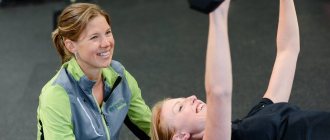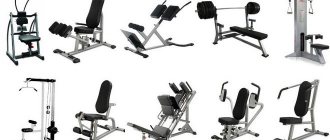Share:
Training in a CrossFit gym has its own characteristics. First of all, it is high intensity, several times higher than this indicator for powerlifters or bodybuilders. Due to the extreme workload, CrossFitters often suffer from nausea after working out in the gym. What to do about it, how to avoid it, and how critical is it?
General information
Before we look at the main causes of nausea after exercise, let’s figure out what nausea is as a physiological symptom. Nausea is a defense mechanism of the body that allows you to remove excess accumulated toxins. At the same time, most of the minerals and salts in the body are eliminated.
The causes of nausea are the accumulation of toxins or irritation of the mucous membrane of the stomach and intestines. Nausea is caused by an excess of bile or a lack of stomach acid, which leads to rotting of food. In addition, nausea can be caused by blood intoxication, which the body fights in this way.
During the training process, the body works in stress mode, which implies an emergency release of energy, which is accompanied by the release of additional toxins and irritation of all body systems. Therefore, nausea during or after exercise occurs as a result of stress.
When to see a doctor
Nausea and other gastrointestinal symptoms during exercise can be uncomfortable. However, they do not usually pose a health hazard. You can prevent exercise-induced nausea by changing your eating and drinking habits, warming up and cooling down properly, and reducing the intensity of your workouts.
If changing eating and exercise habits does not help, or people have long-lasting symptoms or frequent nausea, they should see a doctor.
It is also important to see a doctor if you experience severe symptoms such as blood in the stool, vomiting blood, or severe abdominal pain. These symptoms may indicate a serious illness.
Causes of nausea after exercise
So, if we consider the causes of nausea after training in the gym, we can distinguish two main factors: the accumulation of toxins and irritation of the gastric mucosa.
However, there are other provoking conditions:
- pressure;
- initially feeling unwell;
- gastrointestinal overload;
- lack of water/salt;
- lack of blood sugar;
- overheat;
- decreased blood flow to the gastric mucosa;
- overload and, as a result, exhaustion of strength;
- third party factors.
Pressure
Blood pressure problems occur due to a lack of oxygen. In the process of performing heavy basic exercises, the pressure first increases critically. This can be the result of improper breathing (for example, holding your breath while performing a deadlift), or simply an excessively high load. Then it may drop sharply, which is accompanied by nausea.
Initially feeling unwell
If you initially felt unwell - you were poisoned the day before or are experiencing a slight malaise caused by a cold, then this, in turn, can lead to nausea during training.
Gastrointestinal tract overload
In an effort to eat on a schedule, people often don't take into account their workout time. The optimal time to eat is 1.5 hours before training. If you did not have time to refuel in time, use a gainer or protein shake, which practically does not burden the gastrointestinal tract.
Lack of water/salt
This is due to high intensity training, which leads to profuse sweating. Along with sweat, sodium ions also leave the body. This can be easily stopped by drinking mineral water before or during training.
Lack of blood sugar
This is the flip side of proper nutrition. If you didn't get enough carbohydrates at your last meal, your body may be slow to release glycogen into your bloodstream, leading to low blood sugar and resulting in severe nausea.
Overheat
If you exercise outside or are in the drying phase, you are constantly losing water due to the external heat. If the body is not cooled enough (for example, during a cross-country race), then such overheating can lead to nausea and other unpleasant consequences. Overheating often causes pressure surges and even leads to fainting.
Reduced blood flow to the gastric mucosa
As a rule, this is a medical problem associated with either anemia or pathological changes in the gastrointestinal tract itself. If you suffer from insufficient blood flow to the lining of the gastrointestinal tract, you need to see a doctor to correct this problem.
Third party factors
Among other things, nausea can be caused by third-party factors. These include, for example, an unpleasant smell in the gym in winter, when the air conditioner is not working at full capacity, an allergy to the deodorant of a training partner, and the like.
We must not forget about the most important factor that causes nausea - the desire for new achievements. Increased intensity of training leads to the effect of overtraining.
What is the overload of the body? It's simple. During the process of glycogen release, toxic alkaloids accumulate, which the liver normally copes with. However, if the stress is excessive, then under the influence of adrenaline it will be difficult for you to determine an adequate load for yourself. Therefore, after the adrenaline subsides, overload and an abundance of toxins in the blood can lead not only to nausea, but also to vomiting.
If you don't know why you feel sick after a workout, try comparing your load over the last few sessions and WODs.
Muscle pain after exercise
Diabetes
13159 03 March
IMPORTANT!
The information in this section cannot be used for self-diagnosis and self-treatment.
In case of pain or other exacerbation of the disease, diagnostic tests should be prescribed only by the attending physician. To make a diagnosis and properly prescribe treatment, you should contact your doctor. Muscle pain: causes of occurrence, what diseases it occurs with, diagnosis and treatment methods.
Definition
Muscle pain that occurs after physical activity is called sore throat. Soreness is a kind of indicator of stress on the muscles - the stronger the post-workout pain, the more stress the muscles experienced.
Types of muscle pain after exercise
There are several types of pain that occur after training:
- moderate post-workout muscle pain - appears the day after training, has a pulling nature and intensifies when the corresponding muscle contracts or stretches;
- delayed muscle pain - develops 2-3 days after training, has a strong aching character;
- traumatic muscle pain - occurs during exercise, immediately after or the next day, is acute and constraining in nature.
Possible causes of muscle pain after physical activity When
muscles contract, they consume oxygen, which is necessary for their effective functioning - the more intense and frequent the contractions, the more oxygen is required by muscle cells (myocytes).
If muscles experience hypoxia (lack of oxygen), then another method of “extracting” energy is activated – anaerobic glycolysis.
Anaerobic glycolysis is the process of energy production by body cells through various transformations of glucose with the release of adenosine triphosphate (ATP), occurring under anaerobic (oxygen-free) conditions. In other words, as a result of the breakdown of glucose, a certain amount of ATP molecules are released, which provide energy, and lactic acid (lactate), the excess of which leads to muscle soreness after exercise.
The lactate content in the cells of a healthy person ranges from 0.6 to 1.3 mmol/l; this indicator is used to evaluate the quality and intensity of muscle oxygen saturation and the quality of carbohydrate metabolism. In some diseases accompanied by seizures, lactate levels are higher than normal.
Lactic acid is normally found in the cells of the liver, brain, muscles, heart and other organs.
In the liver, the process of reverse glycolysis occurs - a chain of chemical reactions, as a result of which glucose is obtained from lactic acid, which is used for further transformations to produce energy.
Another cause of pain after physical activity is muscle microtrauma. More often they occur in people who exercise irregularly. In an untrained person, the muscle fibers contain myofibrils (the main contractile elements of muscles) of different lengths - short and long. During eccentric exercise (when tense muscles lengthen under load), the short myofibrils are torn.
What diseases can cause muscle pain?
Lactic acid can accumulate not only in people who exercise occasionally. Lactate levels increase in a number of diseases - such as diabetes mellitus, kidney damage, leukemia, sepsis, acute blood loss, etc.
A pathologically high level of lactic acid leads to the development of such a life-threatening condition as lactic acidosis, as a result of which the acidity of the body’s environment changes, which leads to disruption of the functions of all systems and organs at the cellular level.
Which doctors should I contact for muscle pain?
Before you start visiting a gym or fitness center, it is advisable to undergo a preventive examination and take a series of blood tests.
If any pathology is detected, the intensity of training, its volume, duration and frequency should definitely be discussed with a fitness instructor or sports medicine doctor.
Diagnosis and examinations for muscle pain
As a rule, muscle pain goes away on its own after training. However, a preventive examination and research results will allow a trainer or fitness instructor to adjust individual training, preventing the development of muscle pain.
For the convenience of patients, the INVITRO laboratory has developed special sets of examinations for men and women of different age groups (men over 25 years old, over 40 years old, over 50 years old; women over 25 years old, ), which include examinations by specialists and certain tests to evaluate the work body and identify the presence or risk of developing diseases of the bronchopulmonary, cardiovascular, endocrine and other systems.
What to do if you experience muscle pain after exercise?
A lack of microelements in people involved in sports can cause a malfunction of organ systems. There are a number of screening examinations that allow timely identification and replenishment of the level of missing substances.
Prevention
What to do if you feel nauseous after training? No one is immune from nausea. First of all, you need to drink a sufficient amount of cool liquid and, if possible, eliminate the cause of the nausea itself. If nausea does not stop, the training process must be interrupted. But how can you reduce the risk of nausea?
There are some simple recommendations for a number of parameters:
- Training diary. It is needed so that you do not overload yourself in your next workout. Always write down not only your current results, but also make plans for your next workout. This will reduce the chance of overload.
- Nutrition. Eat food according to the precepts of Soviet trainers - that is, no later than 2 hours before the workout itself. At the same time, you need to eat in moderation, and before the workout itself it is better to load up on carbohydrates, and not proteins and certainly not fats.
- Breath. We have already written about the importance of breathing in each exercise in many articles. Proper breathing stabilizes blood pressure during the approach; in addition, it promotes complete aerobic glycolysis, which will not allow sugar to fall below a certain level.
- Liquid. Protects against overheating, in addition, during the training process you will experience severe dehydration and loss of sodium ions. Good mineral water without gas will help stop this process.
Preventing nausea
We have found out the causes of nausea after running and strength training, now we will briefly talk about how to avoid this phenomenon:
- On training days, do not eat heavy foods - fatty, spicy, high in calories. Of course, you can’t exercise on a full stomach. If you haven’t had time to have lunch, and strength training is on your way, drink a protein shake an hour before it.
- During your workout, drink enough liquid - clean water, still mineral water, isotonic water, fresh fruit juices. Check out the full list of what to drink during training and choose what's right for you. Do not drink alcohol, neither during training, nor after, nor before it. And even on rest days, also abstain. And in general, the sports mode does not accept alcohol.
- Eat right to avoid intestinal problems. The diet should contain foods rich in fiber, fresh vegetables and fruits (including bananas). Drink plenty of water.
- Choose a comfortable and modern gym for your workouts. The temperature there should be regulated and ventilation should work well. Exercise carefully in a thermal suit and listen to your feelings.
- Do not overtighten corsets or tight belts during exercises that require you to push hard on your stomach.
- Eat a balanced diet, especially if you are on a low-carb diet. Make it a rule to eat a juicy fruit before and after training.
- If you have heart problems, monitor your blood pressure on training days. Measure your performance immediately after training. If you don’t feel well, postpone the training without regret, because health is more important than the torso.
- Never exercise if you feel unwell. For example, with the onset of acute respiratory viral infection, PMS, if you are under stress, etc.
- Periodically take a biochemical blood test to monitor its composition and prevent the development of various deficiencies;
- Take supplements adequately. Sports nutrition should help, not harm;
- Periodically drink multivitamin complexes, because an actively training body often lacks useful elements from food and supplements.
- Get plenty of rest, exercise no more than 4 times a week, and get enough sleep.
Well, we found out why many athletes feel sick and vomit after running, and also explained how to avoid the unpleasant symptom. In conclusion, here are 4 factors, the presence of which indicates that a person definitely needs to see a doctor:
- If vomiting does not stop after exercise for several hours. Why this happens, only a doctor can determine;
- If you feel sick not only after training, but also on rest days, and in general, constantly;
- If nausea is accompanied by other symptoms: diarrhea, fever, skin rash, any pain, etc.;
- If the nausea is so severe that you pass out.
Remember, normal physical activity should not be accompanied by unpleasant symptoms. If this happens, it means you are doing something wrong. Why not re-read our article to find the possible reason and solve it? We hope that we don’t need to explain why you can’t train if you have health problems. First - the certificate, then - the bar, and only in that order. Only in this case will sport give you health, beauty, and physical strength.











